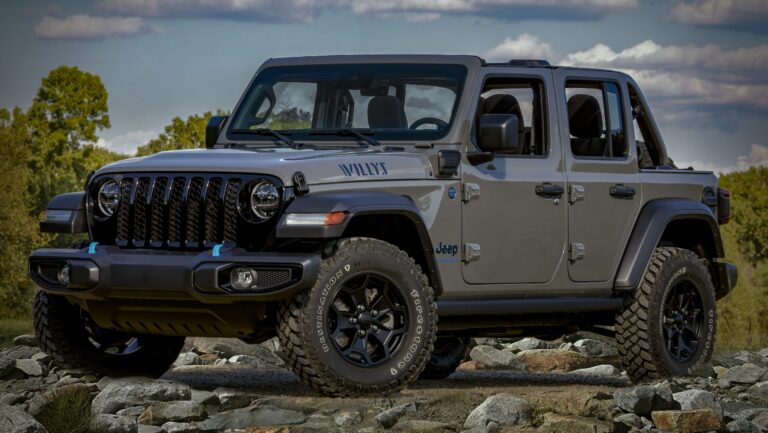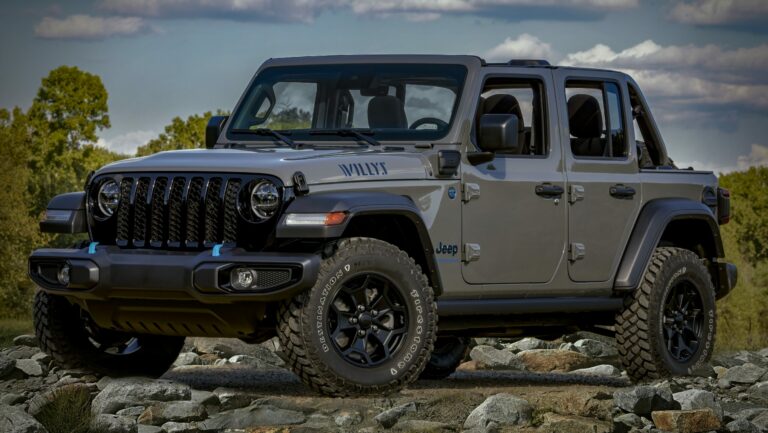Jeep 1979 CJ5 For Sale: A Comprehensive Buyer’s Guide
Jeep 1979 CJ5 For Sale: A Comprehensive Buyer’s Guide jeeps.truckstrend.com
The Timeless Allure of the 1979 CJ5
When the phrase "Jeep 1979 CJ5 for sale" crosses the mind of an automotive enthusiast, it evokes images of rugged adventure, classic design, and a connection to a rich automotive heritage. The CJ5 (Civilian Jeep) series, with its roots stretching back to the iconic Willys MB of World War II, represents the quintessential off-road vehicle. The 1979 model year holds a special place, marking one of the final years of the shorter wheelbase CJ5 before its discontinuation in 1983. It embodies a raw, no-frills approach to motoring that is increasingly rare today, making it a highly sought-after classic for collectors, off-road purists, and anyone yearning for a slice of automotive Americana.
Jeep 1979 CJ5 For Sale: A Comprehensive Buyer’s Guide
This comprehensive guide aims to arm prospective buyers and sellers with the knowledge necessary to navigate the market for a 1979 Jeep CJ5. We’ll delve into what makes this vehicle so desirable, what to look for during an inspection, how to assess its value, and offer practical advice for a successful transaction. If you’re considering a Jeep 1979 CJ5 for sale, understanding its nuances is key to a rewarding ownership experience.
Why the 1979 CJ5 Remains a Coveted Classic
The enduring appeal of the 1979 CJ5 stems from a confluence of factors that make it more than just a vehicle; it’s a statement.
- Iconic Design: With its short wheelbase (83.5 inches), exposed hinges, flat fenders, and removable doors and top, the CJ5’s silhouette is instantly recognizable. It’s a design that prioritizes function over form, yet somehow achieves timeless aesthetic appeal.
- Unmatched Off-Road Prowess: The CJ5’s compact size and short wheelbase contribute to its legendary agility on tight trails. Coupled with solid axles, robust leaf spring suspension, and a simple, reliable 4×4 system, it’s a formidable off-road machine capable of tackling challenging terrain where larger vehicles might struggle.
- Mechanical Simplicity: In an era of increasingly complex automotive electronics, the 1979 CJ5 stands out for its mechanical straightforwardness. This makes it a popular choice for DIY enthusiasts, as maintenance and repairs are often manageable with basic tools and a good service manual.
- Robust Drivetrains: The 1979 CJ5 was equipped with powerful and durable AMC engines, including the venerable 258 cubic inch (4.2L) inline-six and the more potent 304 cubic inch (5.0L) V8. Paired with strong Dana axles and a sturdy Dana 20 transfer case, these powertrains were built to last and endure harsh conditions.
- Nostalgia and Community: For many, the 1979 CJ5 represents a bygone era of adventure and freedom. Its strong cult following has fostered a vibrant community of owners, online forums, and an excellent aftermarket support network, making parts and advice readily available.
Key Specifications and Variants of the 1979 CJ5
To truly appreciate a 1979 Jeep CJ5 for sale, it’s important to understand its core specifications and the variations that were available.
- Engine Options:
- AMC 258 cu in (4.2L) I6: This inline-six engine was the standard powerplant. Known for its torque, reliability, and ease of maintenance, it’s a solid choice for both off-road duty and cruising.
- AMC 304 cu in (5.0L) V8: Available as an option, the 304 V8 provided significantly more horsepower and a distinct V8 rumble. While less fuel-efficient, it offers stronger acceleration and more power for towing or high-speed trail driving.
- Transmission Options:
- Manual Transmissions: The most common were the Borg-Warner T-150 (3-speed), the Borg-Warner T-176 (4-speed), and the lighter-duty Tremec SR-4 (4-speed). The T-176 is generally considered the most robust of the manual options.
- Automatic Transmission: A rare option, the General Motors TH400 3-speed automatic was available exclusively with the V8 engine.
- Transfer Case: All 1979 CJ5s utilized the Dana 20 gear-driven transfer case, a highly durable and reliable unit that offers both high and low range 4×4.
- Axles: The front axle was typically a Dana 30, while the rear was an AMC 20. The AMC 20 is known for its relatively weak two-piece axle shafts, which are often a target for aftermarket upgrades, especially in modified Jeeps.
- Wheelbase: 83.5 inches, defining its compact and nimble character.
- Trim Levels: Beyond the base model, the 1979 CJ5 was available in more upscale trims such as the Renegade and Laredo. These packages typically included cosmetic enhancements like unique graphics, chrome accents, different wheel options, and interior upgrades like bucket seats, gauges, and a padded steering wheel. A Renegade or Laredo model in good condition can command a higher price.

The Pre-Purchase Inspection: What to Scrutinize
Buying a vintage vehicle like a 1979 Jeep CJ5 for sale requires a meticulous inspection. Age and past adventures mean wear and tear are inevitable, and some issues can be costly to remedy.
- Rust: The CJ5’s Arch-Nemesis: Rust is the single biggest enemy of the CJ5. Inspect thoroughly:
- Frame: Pay close attention to the frame rails, especially around body mounts, spring hangers, and skid plate attachments. Check for severe pitting, cracks, or patches.
- Body Tub: Inspect floorboards (front and rear), rocker panels, inner and outer fender wells, and the area around the cowl and windshield frame. These areas are notorious for rot.
- Fenders, Grille, Tailgate: Check for rust, bondo, and poor repairs.
- Mechanical Condition:
- Engine: Listen for knocks, excessive lifter noise, or strange sounds. Check for oil leaks, coolant leaks, and exhaust smoke (blue smoke indicates oil burning, white indicates coolant, black indicates rich fuel mixture). A compression test is highly recommended.
- Transmission & Transfer Case: Test all gears, including 4×4 high and low. Listen for grinding, clunking, or difficulty shifting. Check for fluid leaks.
- Axles & Driveshafts: Inspect U-joints for play. Check differential fluid levels and look for leaks. Listen for humming or clunking noises during a test drive, which could indicate worn gears or bearings.
- Steering: Check for excessive play in the steering wheel. Inspect the steering box, tie rods, drag link, and ball joints for looseness or wear.
- Brakes: Check pedal feel (spongy, hard, or sinking). Inspect lines, calipers/wheel cylinders, and master cylinder for leaks.
- Suspension: Look for sagging leaf springs, worn bushings, and leaking shocks.
- Electrical System: Test all lights, gauges, wipers, heater, and any aftermarket accessories. Wiring issues can be frustrating to diagnose.
- Modifications: Many CJ5s have been modified. Assess the quality of any lift kits, engine swaps, aftermarket bumpers, or custom work. Poorly executed modifications can lead to safety issues and costly repairs.
- Documentation: Always verify the title is clear and matches the VIN on the vehicle. Ask for service records, if available, and try to understand the vehicle’s history.
Understanding Condition and Valuation Categories
The price of a 1979 Jeep CJ5 for sale can vary wildly depending on its condition. Here’s a general guide:
- Project Vehicle: These are typically non-running, have extensive rust, major mechanical issues, or are incomplete. They require significant time, money, and expertise to restore.
- Driver Quality: This category includes Jeeps that run and drive, are functional, but have cosmetic flaws, minor rust, or mechanical issues that need attention but don’t prevent operation.
- Good Condition/Restored Driver: These Jeeps are solid, with minimal rust, reliable mechanics, and presentable exteriors and interiors. They can be driven regularly and may have some tasteful upgrades.
- Show Quality/Concours: These are meticulously restored vehicles, often to original or better-than-new condition. They are pristine, often garnering awards at shows, and command the highest prices.
Factors that significantly influence the price include originality (stock vs. modified), engine type (V8s often fetch more), transmission (manuals are generally preferred), specific trim levels (Renegade/Laredo), geographic location, and the availability of documentation.
Tips for a Successful Purchase
- Research Thoroughly: Understand the common issues and the specific characteristics of the 1979 CJ5. Knowledge is your best tool.
- Set a Realistic Budget: Don’t just factor in the purchase price. Account for taxes, insurance, and inevitable repairs, maintenance, or desired upgrades. Vintage vehicles always have ongoing costs.
- Seek Expert Advice: If you’re not an experienced mechanic, arrange for a pre-purchase inspection by a reputable shop or mechanic who specializes in vintage Jeeps or 4x4s. This small investment can save you thousands.
- Test Drive Extensively: Drive the Jeep on various roads, and if possible and appropriate, on light off-road terrain. Listen for noises, feel for vibrations, and assess how it handles. Test the brakes, steering, and all gears.
- Negotiate Wisely: Be prepared to negotiate based on the vehicle’s condition report. Don’t be afraid to walk away if the price isn’t right or if the seller is unwilling to address concerns.
- Verify Title and VIN: Ensure the vehicle’s VIN matches the title, and that the title is clear of any liens.
Common Challenges and Solutions for 1979 CJ5 Owners
Owning a vintage CJ5 comes with its unique set of challenges, but most have well-established solutions within the enthusiast community.
- Rust Mitigation: Ongoing vigilance is key. Regular cleaning, especially after off-roading or winter driving, and prompt repair of any rust spots are essential. Rust-proofing treatments can also help.
- Fuel Economy: Be realistic. The 1979 CJ5 is not a fuel-efficient vehicle. Expect 10-15 MPG at best. Some owners opt for aftermarket electronic fuel injection (EFI) conversions for better performance and marginally improved economy.
- On-Road Comfort: The short wheelbase, leaf spring suspension, and minimal sound deadening mean a firm, noisy ride. Solutions include aftermarket suspension kits for a smoother ride, better seats, and adding sound deadening materials to the interior.
- Parts Availability: While specific OEM parts can be harder to find, the aftermarket support for the CJ5 is excellent. Most mechanical and body components are readily available from numerous suppliers. Online forums and specialized Jeep parts retailers are invaluable resources.
- Safety Features: Modern safety features like airbags, ABS, and stability control are absent. Drive defensively, and consider upgrades like three-point seatbelts if not already present.
Price Table: Estimated Values for a 1979 Jeep CJ5
| Condition Category | Description | Estimated Price Range (USD) | Key Considerations |
|---|---|---|---|
| Project Vehicle | Non-running, extensive frame/body rust, major mechanical issues, incomplete. | $2,000 – $6,000 | Requires significant investment in time, parts, and professional labor. |
| Driver Quality | Runs and drives reliably, functional, but needs cosmetic/minor mechanical work. | $7,000 – $15,000 | Good entry point for enthusiasts willing to do some work; rust often present. |
| Good Condition/Restored Driver | Solid frame, minimal body rust, reliable mechanics, presentable exterior/interior. | $16,000 – $25,000 | Can be driven regularly, may have tasteful upgrades; a solid investment. |
| Show Quality/Concours | Meticulously restored to original or better-than-new condition, pristine. | $26,000 – $40,000+ | Rare finds, often V8 models or highly desirable trim levels; museum-quality. |
Note: Prices are estimates and can vary significantly based on specific engine (V8s often command more), transmission, trim level (Renegade/Laredo), originality, geographic location, market demand, and seller motivation.
Frequently Asked Questions (FAQ)
Q1: Is a 1979 CJ5 a good daily driver?
A: Generally, no. While it can be driven daily, it lacks modern comforts, safety features, and fuel efficiency. They are better suited for weekend cruising, off-roading, or as a secondary vehicle for enthusiasts.
Q2: What kind of fuel economy can I expect?
A: Very low. Expect anywhere from 10-15 MPG, depending on the engine (V8s will be lower), transmission, tire size, and driving style.
Q3: Are parts readily available for the 1979 CJ5?
A: Yes, very good aftermarket support exists for most mechanical, suspension, and body parts. While some OEM-specific items can be harder to find, they are usually available through specialty retailers or online communities.
Q4: Can I easily modify a 1979 CJ5 for off-roading?
A: Absolutely. The CJ5 is one of the most customizable Jeeps. There are countless aftermarket lift kits, axle upgrades, engine performance parts, and accessories available to enhance its off-road capabilities.
Q5: What’s the main difference between a CJ5 and a CJ7?
A: The primary difference is the wheelbase. The CJ7 has a 93.5-inch wheelbase, which is 10 inches longer than the CJ5’s 83.5 inches. This gives the CJ7 more interior room, better on-road stability, and easier entry/exit, while the CJ5 is more compact and nimble on tight trails.
Q6: What should I budget for annual maintenance?
A: This varies greatly depending on the vehicle’s initial condition and how much you drive it. A well-maintained driver might only need a few hundred dollars annually for routine maintenance. A project vehicle could require thousands in the first year alone. Always factor in potential unexpected repairs for older vehicles.
Q7: How do I insure a classic Jeep like this?
A: It’s recommended to seek out classic car insurance providers like Hagerty, Grundy, or American Collectors Insurance. They often offer agreed-value policies (insuring the vehicle for an agreed-upon value, not just market value) and lower premiums, especially if the vehicle is not driven daily.
Conclusion: The Enduring Legacy of the 1979 CJ5
The pursuit of a "Jeep 1979 CJ5 for sale" is more than just a car purchase; it’s an investment in a piece of American history and a ticket to a unique driving experience. The 1979 CJ5 embodies the rugged simplicity and adventurous spirit that defined the Jeep brand for decades. While it demands a certain level of commitment in terms of maintenance and realistic expectations regarding modern comforts, the rewards of owning and driving this iconic vehicle are immeasurable. With careful research, a thorough inspection, and a clear understanding of its characteristics, you can find a 1979 CJ5 that will provide years of enjoyment, whether on the trail or simply cruising down a back road, turning heads and sparking conversations wherever it goes.







